Trail Scouting with
Mariner Girl Scout Troop 361
Scouting Eagle Trail at Eagle Cave in
Blue River, Wisconsin
Eagle Cave is known as Wisconsin's largest onyx cave that was additionally the first cave to be commercially owned and operated in Wisconsin. The cave was discovered in 1849 and first opened to the public in 1938. It is a popular camping destination during the fall, winter, and spring months, when youth group campers are allowed to camp inside the cave and participate in their cave exploratory program that has been operating since 1954.

Cave Entrance
December 12-14th 2014 found the Mariner Girl Scout Troop 361 at Eagle Cave for the 20th year in a row and myself along as a chaperone for a first time visit
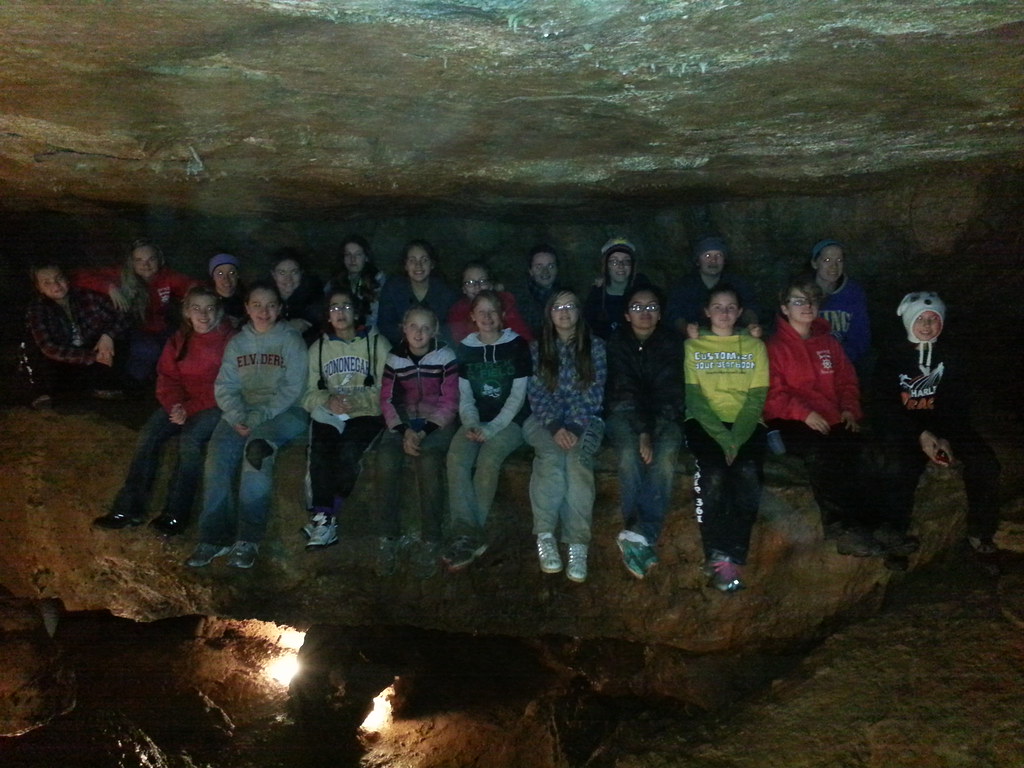
The 21 girls that were along for the adventure; some there for the first time, others repeat offenders.
The Cave itself offers over 3000ft of passage covering four main levels. Each level comes with additional underground subterranean tunnels, some so tiny you feel you can barely fit your body. Travel is limited to wiggling back and forth, pulling yourself along with your forearms, as if crawling under barbed-wire in an army obstacle course minus the wire, replaced instead with hard onyx-infused rock. Let the bruises commence.

Eagle Cave Map as obtained from the gift shop.
Our weekend included three days of possible cave exploring (we only took advantage of two leaving directly after breakfast Sunday morning) two nights of in-cave sleeping, four provided meals and a Friday evening snack of homemade donuts and coco, outdoor hiking trails, compass activities, and access to any additional activities that the camp manages offer like group bingo or a game of find the hidden objects within the cave.

The cave's main floors a lit with floor lamps while the sub terrain passages require additional light to explore or a guide who has been in the passages more times than once to lead you around in the dark on a trust crawl.

One of several staircase fabricated within the cave for easy traversing.
Saturday the 13th of December dawned 40 degrees with a thick heavy fog that covered the entire outdoor campsite.

Friday evening, the assistant scout leader and I made mention of attempting the 5 mile Eagle Trail (original right) if the day proved to be warm. The following morning a group of four girls and two additional adults would accompany us on our scouting endeavor.

Our adventure immediately got off on the wrong the wrong track, walking right past the trail head and traveling all the way down to the red campsites turn around. The extra walk made for some fun sliding along the frozen road.

Let the game of trail blaze hide-and-seek commence.

Once the trail head was actually found it led us far downhill to the eastern most property line marked with red tipped fence posts. It took us all the way to the end to realize that the red-tipped posts were to be a replacement for trail blazes when none were in sight.

Ganoderma applanatum
On our adventure we took note of a plethora of different fungal species. This first most closely resembles Ganoderma applanatum also know as Artist's Bracket, Artist's Conk, or Flacher Lackporling. The spore bodies can grow up to 30–40 centimeters (12–16 in) across, contain a hard, woody-textured, and are inedible; they are white at first but soon turn a dark red-brown.
This is a wood-decay fungus that primarily digests moist heartwood, causing it to rot that can also survive as a pathogen(infectious agent) on live sapwood.
Quick wood type lesson: Sapwood (or alburnum) is the younger, outermost wood; in the growing tree it is living wood, and its principal functions are to regulate water took up from the roots and transport it the leaves. However, by the time they become competent to conduct water thoroughly, all xylem tracheids (fancy tree science word for dead water transport vessels) have lost their cytoplasm and the cells shrink and become nonfunctional. As additional sapwood grows on the exterior ring of the tree underneath the bark these dead cells become heartwood.
Heartwood (or duramen) is wood that as a result of a naturally occurring chemical transformation has become more resistant to decay. Heartwood formation occurs spontaneously as it is a genetically programmed process into the life of the tree. Once heartwood formation is complete, the heartwood is considered "dead".
A peculiarity of this fungus lies in its ability to be used as a drawing medium for artists, hence its common naming. When the surface is rubbed or scratched with a sharp implement, it changes from light to dark brown, producing visible lines and shading.
This is a wood-decay fungus that primarily digests moist heartwood, causing it to rot that can also survive as a pathogen(infectious agent) on live sapwood.
Quick wood type lesson: Sapwood (or alburnum) is the younger, outermost wood; in the growing tree it is living wood, and its principal functions are to regulate water took up from the roots and transport it the leaves. However, by the time they become competent to conduct water thoroughly, all xylem tracheids (fancy tree science word for dead water transport vessels) have lost their cytoplasm and the cells shrink and become nonfunctional. As additional sapwood grows on the exterior ring of the tree underneath the bark these dead cells become heartwood.
Heartwood (or duramen) is wood that as a result of a naturally occurring chemical transformation has become more resistant to decay. Heartwood formation occurs spontaneously as it is a genetically programmed process into the life of the tree. Once heartwood formation is complete, the heartwood is considered "dead".
A peculiarity of this fungus lies in its ability to be used as a drawing medium for artists, hence its common naming. When the surface is rubbed or scratched with a sharp implement, it changes from light to dark brown, producing visible lines and shading.

The four brave girl scouts that came on the adventure, resting after a long uphill climb.
Many different times we would loose site of the blazes and have to backtrack or send one off to scout ahead until the faded red trail marker was spotted. This would go on to add additional time to our adventure that we did not intend.

The initial fellowship of adventures. Props to G and Mrs. Stenerson for joining us on the adventure.
With patience we would eventually find our way all the while accompanied by the fun commentary and exchanges of the fellowship.

Phellinus everhartii
Our second fungus sighting would turn out to be Phellinus everhartii, commonly known as Canker Rot. It most commonly forms on oaks in eastern half of North America's hardwood forests but has been known to grow on additional hardwood species. Phellinus everhartii is known to be a tough, woody, perennial polypore that attacks living trees as a parasite.
Polypores are a group of fungi that form fruiting bodies with pores or tubes on the undersides are among the most efficient decomposes of lignin and cellulose, the main components of wood. Polypores are also called bracket fungi, and their woody fruiting bodies are called conks.
Everhartii features a convex cap that continually becomes hoof-shaped over the years, with a varying brown pore surface composed of very minute pores.
Polypores are a group of fungi that form fruiting bodies with pores or tubes on the undersides are among the most efficient decomposes of lignin and cellulose, the main components of wood. Polypores are also called bracket fungi, and their woody fruiting bodies are called conks.
Everhartii features a convex cap that continually becomes hoof-shaped over the years, with a varying brown pore surface composed of very minute pores.

The trail would cover various elevation changes challenging our endurance and balance, while giving our muscles a decent workout and stretch.

Can you spot the trail blaze in the picture below. I'll give you a clue, its on the right side of the photo.

Havin' a hard time seeing the blaze??? Yeah. Welcome to about 4 out of the 5 miles of our hike.

This photo should have a simpler spot.

The above photo an even simpler one.
So did you spot all three blazes, because we did and our party pressed on.
So did you spot all three blazes, because we did and our party pressed on.
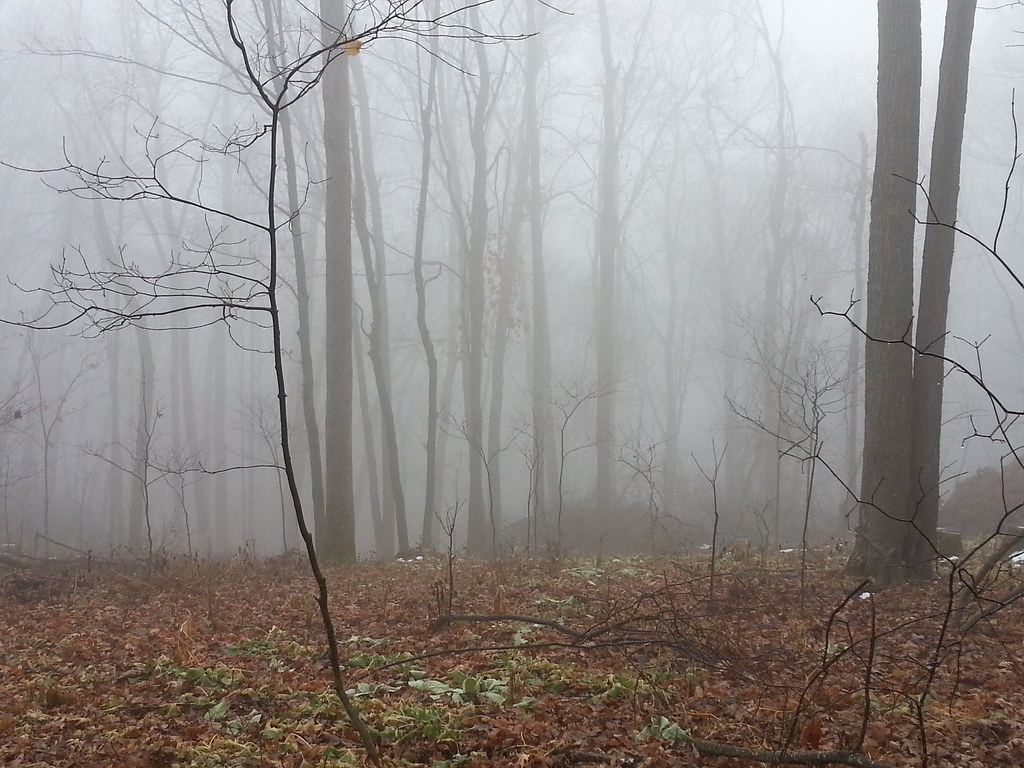
We would stop here for a quick lesson about the invasive species Garlic Mustard and the fuzzy leaved Lamb's Ear.
 Lamb's Ear or Mullen (not my picture)
|
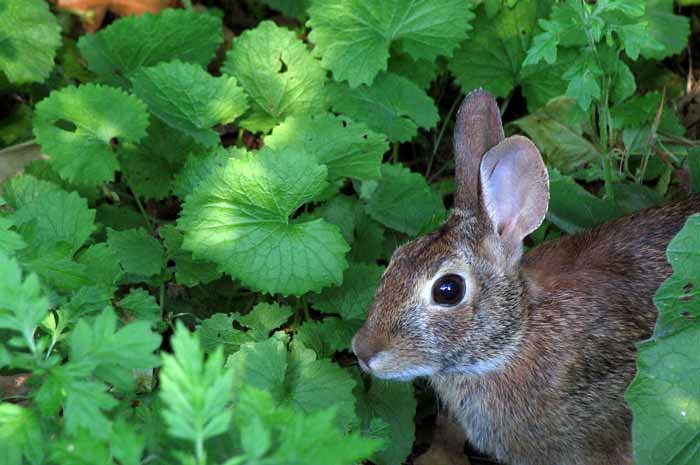 Garlic Mustard (not my picture)
|
Lesson of the hike included how Lamb's Ear (Stachys byzantina) is also known as "Scouting Toilet Paper"; as the leaves can make a wild toilet paper substitute as it is very soft and the "fur" helps with the cleaning process. It also can be used as a gauze bandage substitute assuming you can find something to strap it on with. The highly invasive Garlic Mustard (Alliaria petiolata) leaves when chopped or crushed are used for flavoring in wild salads, sauces, and pesto. The flavor is best when young, and provide a mild flavor of both garlic and mustard.

Somewhere along our hike we would pass from the Winter setting into a Fall backdrop. It looks as if the area always receives a wind that flows from left to right in this photo and the tree limbs all seem to lean in this direction.

The trail lead us down another hill to the western most border of the land where we would again follow the red fence posts, still a bit confused with the absence of trail blazes, not fully understanding that these were to be the replacement when following along the property line, but trusting the way as the signs of previous travel could be seen in the turned over leaves.

The trail would eventually lead us to this mini gorge that would require a bit of an extra energy to cross, be it a jump, balance, or climb check.

I myself chose to jump the gap, while the four other girl scouts would follow suit. The adults would find a slower route to cross but all parties would be successful.

Angelica sporting a happy smile after successfully passing her jump check, not quite getting the video setting ready on my phone before her leap.

Along the path we would go on to pass a few outcroppings. Geology is such a cool thing and that is a subject I could spend hours talking about, yet that is not what this post it to be about, so I will spare you the rockin' talk until another time.

Instead let us segue back to fungus, as that is where time was put on this hike. I sadly have been unable to identify this tiny fungus with the resources I have been using. It looks as if baby seashells have adhered themselves to this stick, with fans roughly the size of a fingernail.

Polyporus squamosus
Polyporus squamosus is a type of bracket fungus with common names including Dryad's Saddle and Pheasant's Back Mushroom. It has a widespread distribution, being found in North America, Australia, Asia, and Europe, where it causes a white rot in the heartwood of both living and dead hardwood trees. The name "Dryad's saddle" comes from story of Greek mythology. It was conceived that minor female nature deity typically associated with a particular location or landform called, (guess what...) Dryads, could fit and ride on this mushroom. The pheasant's back analogy is derived from the pattern of colors on the bracket matching the markings of a pheasant's back.
They can be found alone, in clusters of two or three, or form shelves. Young specimens are edible when soft but toughen with age. Cookbooks dealing with preparation generally recommend gathering these while young, slicing them into small pieces and cooking them over a low heat. With the proper preparation technique, this and many other mushrooms of the genus Polyporus, are know to produce a thick and stiff paper.
They can be found alone, in clusters of two or three, or form shelves. Young specimens are edible when soft but toughen with age. Cookbooks dealing with preparation generally recommend gathering these while young, slicing them into small pieces and cooking them over a low heat. With the proper preparation technique, this and many other mushrooms of the genus Polyporus, are know to produce a thick and stiff paper.

Gloeoporus dichrous
Gloeoporus dichrous is a polypore with no common name and remains a decomposer of hardwood logs across the continent. Viewed from above, it possesses a creamy to white cap and contains striking underside features an unexpected brown to reddish brown pore surface. This fungus is saprobic on dead hardwoods and even has been sighted on conifers, though the added acid deters them. Mushrooms that are saprobes survive by decomposing dead or decaying wood, while other wood rotters are parasitic and attack living wood. Most yard and garden mushrooms are saprobes, as well as dung-loving mushrooms and mushrooms that decompose leaf or needle litter.
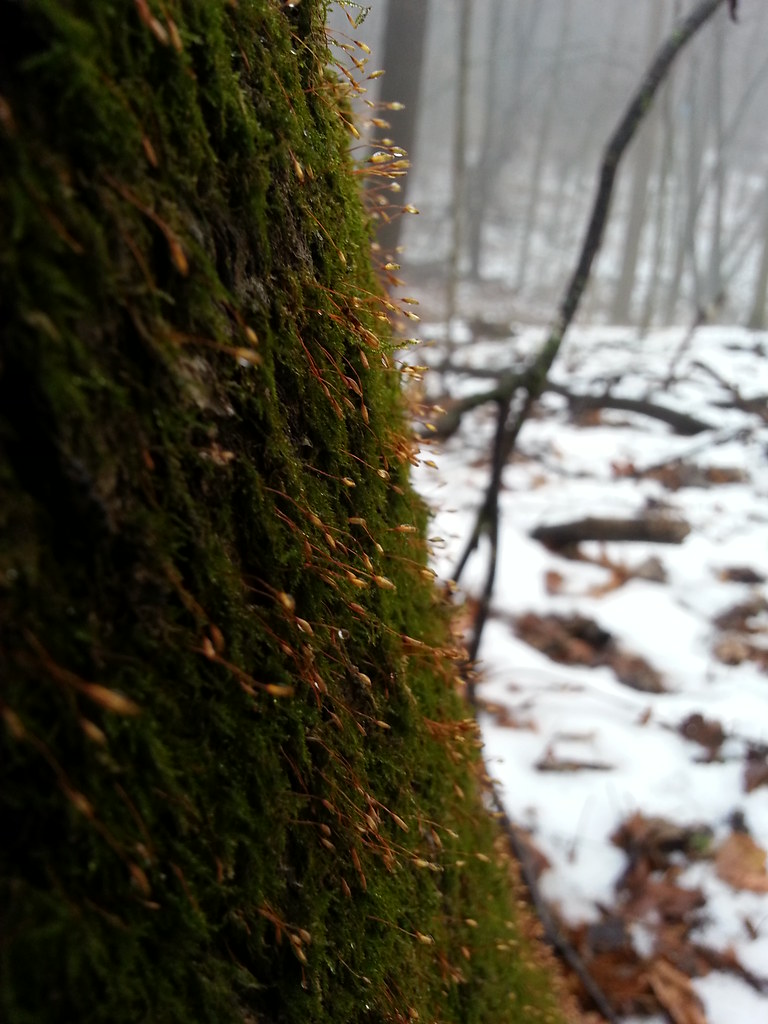
Tree moss in its Sporophyte stage.
Bryophyte is a traditional name used to refer to all embryophytes (scientific word for land plants) that do not have true vascular tissue and therefore are called "non-vascular plant." Vascular tissue is a complex conducting tissue, formed from multiple cell types more than one cell type, found in vascular plants. The primary components of vascular tissue are the xylem and phloem. These two tissues transport fluid and nutrients internally. The name Bryophyte is convenient and remains in use as a collective term for mosses, hornworts, and liverworts.
This moss is in its Sporophyte stage. It develops from the zygote (initial cell formed when two haploid gamete {single set of male and female chromosomes, each one not being a pair} reproduce.) The sporophyte produces spores (hence the name) by meiosis, a process also known as "reduction division" that reduces the number of chromosomes in each spore mother cell by half. The resulting spores develop into a haploid gametophyte. As the gametophyte matures it produces both male and female gametes by mitosis. The fusion of male and female gametes produces a diploid (two sets of chromosomes) zygote which develops into a new sporophyte. This cycle is known as "alternation of generations" or alternation of phases.
Lesson of the trail covered how mosses require water to reproduce, as they contain no vascular tissue to aid in transportation. Some species, for example Mnium hornum or several species of Polytrichum, keep their antheridia (organ producing male gametes- much like the male sperm) in so called 'splash cups'; bowl-like structures on the shoot tips that propel the sperm several decimeters when water droplets hit it, increasing the fertilization distance.
Yeah! Evolutionary Biology Class coming in useful again. Go College Degree, Go!
This moss is in its Sporophyte stage. It develops from the zygote (initial cell formed when two haploid gamete {single set of male and female chromosomes, each one not being a pair} reproduce.) The sporophyte produces spores (hence the name) by meiosis, a process also known as "reduction division" that reduces the number of chromosomes in each spore mother cell by half. The resulting spores develop into a haploid gametophyte. As the gametophyte matures it produces both male and female gametes by mitosis. The fusion of male and female gametes produces a diploid (two sets of chromosomes) zygote which develops into a new sporophyte. This cycle is known as "alternation of generations" or alternation of phases.
Lesson of the trail covered how mosses require water to reproduce, as they contain no vascular tissue to aid in transportation. Some species, for example Mnium hornum or several species of Polytrichum, keep their antheridia (organ producing male gametes- much like the male sperm) in so called 'splash cups'; bowl-like structures on the shoot tips that propel the sperm several decimeters when water droplets hit it, increasing the fertilization distance.
Yeah! Evolutionary Biology Class coming in useful again. Go College Degree, Go!

Slime Molds
Slime mold or slime mould is a broad term describing a variety of organisms that use spores to reproduce. Slime molds were formerly classified as fungi but are no longer considered part of this kingdom.
Found in a wide variety of colors, more than 900 species of slime mold occur all over the world. Their common name refers to part of some of these organisms' life cycles where they can appear as gelatinous "slime". Most slime molds are smaller than a few centimeters, but some species may reach sizes of up to several square meters and masses of up to 30 grams.
Found in a wide variety of colors, more than 900 species of slime mold occur all over the world. Their common name refers to part of some of these organisms' life cycles where they can appear as gelatinous "slime". Most slime molds are smaller than a few centimeters, but some species may reach sizes of up to several square meters and masses of up to 30 grams.

Trametes versicolor (Turkey Tail)
Meaning 'of several colors', versicolor describes this mushroom found in different colors. Its cap colors are extremely variable, but tend to stay in the buff, brown, cinnamon, and reddish brown range. By example, due to its resembling multiple colors in the tail of wild turkey, T. versicolor is commonly called Turkey Tail.
 Trametes versicolor is one of the most common mushrooms in North American woods, found virtually anywhere there are dead hardwood logs and stumps to decompose--and, occasionally, on conifer wood too.
 |
 The mushrooms are strikingly "zonate" with sharply contrasting concentric zones of color, and the surface of the cap is finely fuzzy or velvety. Often the zones represent contrasts in texture as well as color, so that fuzzy zones alternate with smoother ones.
 |
Trametes cervina looks a lot like Trametes versicolor or Turkey Tail but the color of pore surface is pink or orange instead of violet or purple.

Trametes cervina
Tyromyces chioneus, commonly known as the White Cheese Polypore, is a species of polypore fungus. A widely distributed fungus, it has a circumpolar distribution, in temperate boreal pine forests, of Asia, Europe, and North America, causes white rot in dead hardwood trees, especially birch.

Tyromyces chioneus
 |
 |
Along the way we encountered a few additional species that I have been unable to identify. Among them this species who's close up is on the right that would engulf this entire patch of downed trees.

Additionally unidentified are these two fungi. If anyone has any idea at identifying the above and below please comment in the forum below, or shoot me an e-mail in the contact page.
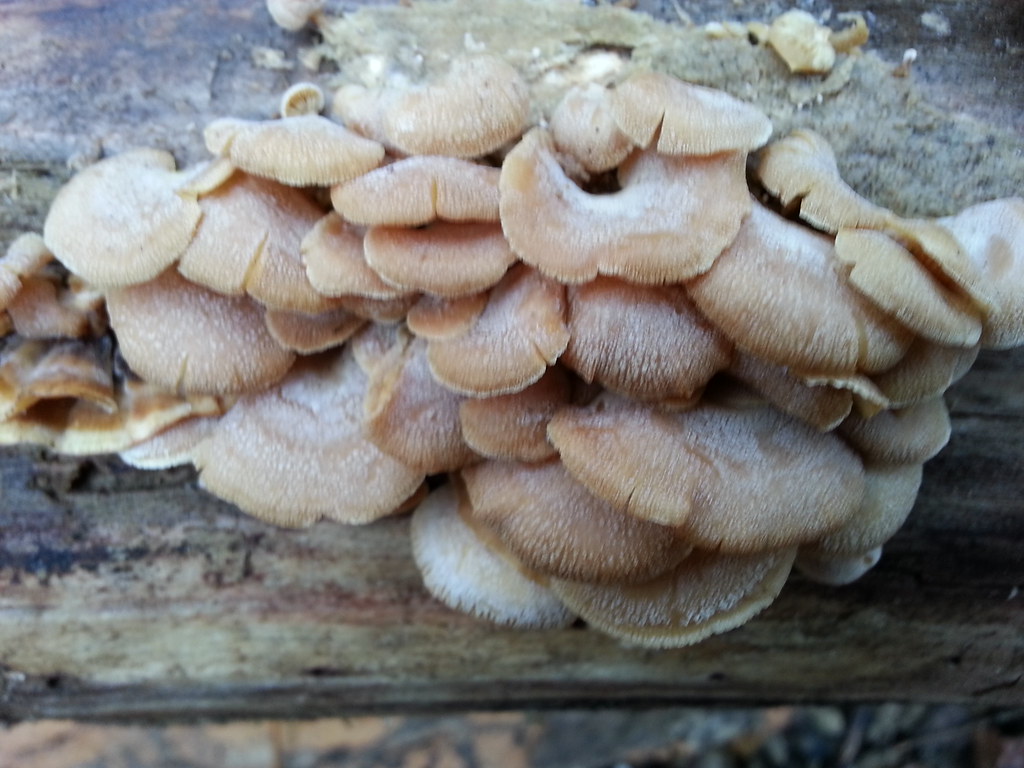
The trail would lead us past the lake that when thoroughly frozen is an additional attraction to the public as a place to ice skate.

This events warmer weather made that activity unacceptable, not that we were complaining as it made for great hiking weather.
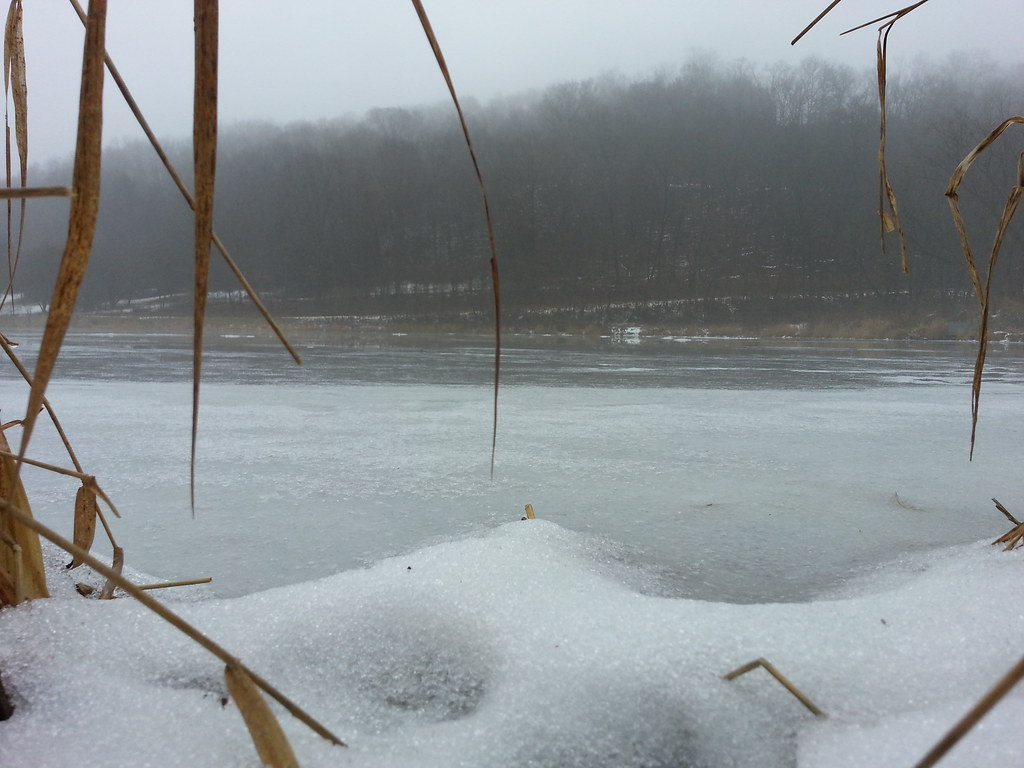
After a game of hide and trail blaze seek that we did not intend to play, our hike had taken more time than we anticipated. About the same time 361 was scheduled for lunch our hiking trail conveniently crossed the entrance road about 3-3.3miles into our 5 mile trek. A pole was taken and the troops decided that it would be better to travel uphill back to the commons and rally the rest of the troop for lunch.

Saddened a bit that we were unable to finish our 5 mile scouting quest, I would attempt to rally the troops after lunch to finish, but all were content leaving the quest unfinished.

I however, had plans to finish what was started alone or otherwise. Gratefully, I was able to convince Rebecca to finish the adventure with me.

The remainder of the hike was just as difficult to scout as the first section, for the fog refused to let up as the day turned long. About an hour later our adventure would eventually find us back at the cave entrance where the five mile red trail ended.

Acheivement Unlocked: 5 mile trail completion in the thick fog. (+Scouting exp) (+tracking exp) (+Nature exp) (+strength exp) (+endurance exp) (+agility exp) (+memories)

Completely unrelated photo, just couldn't help myself from posting this great picture of Ramos and Hall being totally photo bombed by some other boy scout from behind.

While I am not intending to have any children in my lifetime, I am much more content with having 30 little sisters. Thank you 361 for making me feel so welcomed into your group. May we have many more adventures together.

Quick References:
http://www.wisconsinmushrooms.com/Ganodermaapplanatum.html
http://en.wikipedia.org/wiki/Ganoderma_applanatum
http://en.wikipedia.org/wiki/Wood#Heartwood_and_sapwood
http://www.wisconsinmushrooms.com/Phellinuseverhartii.html
http://www.mushroomexpert.com/phellinus_everhartii.html
https://en.wikipedia.org/wiki/Polyporus_squamosus
http://www.mushroomexpert.com/gloeoporus_dichrous.html
http://en.wikipedia.org/wiki/Slime_mold
http://en.wikipedia.org/wiki/Trametes_versicolor
http://www.mushroomexpert.com/tyromyces_chioneus.html
http://www.wisconsinmushrooms.com/Ganodermaapplanatum.html
http://en.wikipedia.org/wiki/Ganoderma_applanatum
http://en.wikipedia.org/wiki/Wood#Heartwood_and_sapwood
http://www.wisconsinmushrooms.com/Phellinuseverhartii.html
http://www.mushroomexpert.com/phellinus_everhartii.html
https://en.wikipedia.org/wiki/Polyporus_squamosus
http://www.mushroomexpert.com/gloeoporus_dichrous.html
http://en.wikipedia.org/wiki/Slime_mold
http://en.wikipedia.org/wiki/Trametes_versicolor
http://www.mushroomexpert.com/tyromyces_chioneus.html
